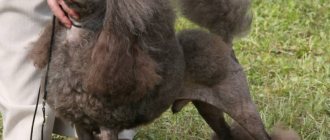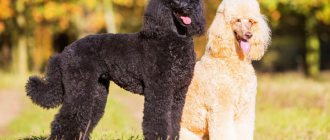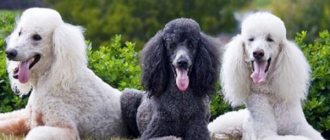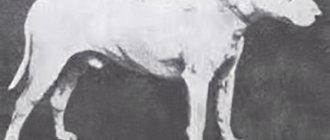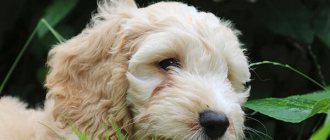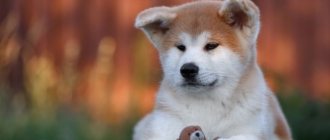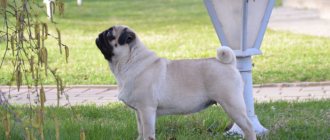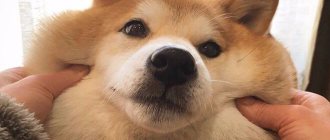The miniature poodle was only recognized in 1097 and was previously called "toy", although these are 2 distinct varieties. Today, the mini poodle is one of the most common decorative breeds in the world, largely due to its compact size and good tolerance to almost any climate.
The miniature poodle was only recognized in 1097 and was previously called "toy", although these are 2 different varieties
Gallery: miniature poodle (25 photos)
What is it for?
Today they are considered an ornamental breed, but once they were kept for hunting - to lift waterfowl on the wing and serve wounded birds to the hunter. In addition, medium and large individuals were considered excellent watchdogs. This character trait is also inherent in modern representatives of the breed.
But hunting and guarding are not the only occupation of dogs. Large and medium black poodles accompanied sailors on voyages and desperately helped military doctors and soldiers on campaigns. Another occupation of medium and small individuals was performing as circus performers in a traveling circus. Small dogs were simply pets.
Character and habits of the miniature poodle
These four-legged pets are characterized by curiosity, a sharp mind (it’s not for nothing that they rank second in intelligence after the border collie), receptivity and a cheerful, gentle disposition. They are obedient, want to be the center of attention and cannot stand being alone. They learn easily, become strongly attached to people, and can be very dependent on the emotions of the owner.
Children and other pets, such as cats, usually find poodles to be kind and sociable (even if the cat itself is not happy about it), but some dogs can be very jealous or overly excitable. The poodle's sensitivity means that if he is offended, the four-legged friend's behavior will become destructive until the owner apologizes.
The poodle can exhibit guarding qualities to protect its owner, but is more often limited to loud barking without attacking. In general, young poodles like the sound of their own voice, which is why they can become annoying with frequent barking. Although this will pass with age, you should not let it become a habit for your dog.
Among strangers, a mini-poodle behaves distrustfully and warily, just as a cat acts nervous among strangers. However, you should not think that he can easily get lost: these dogs are hardy and, thanks to their excellent sense of smell and memory, they can easily find the shortest path to home, even if they are far from it.
Varieties of colors
The standard for representatives of the dwarf poodle breed allows several solid colors: black, apricot, peach, brown (any shade), silver (gray) or white. Since 2007, the color has been recognized as brown-red (red).
In the Russian Federation and a number of other countries, the tan color (phantom) and harlequin are adopted as standard. Miniature poodles with such a rare color are more expensive than solid ones.
Care and maintenance of a mini poodle
The Miniature Poodle requires careful grooming. It is important to accustom him to hygienic and preventive procedures from early childhood so that the dog does not show aggression and irritation during them. The dog needs to be bathed 1-2 times a week using special shampoos and mild conditioners, since it is vital for them to keep their coat always clean. The coat should be combed several times a week, especially since the poodle enthusiastically accepts this procedure. It is advisable to have brushes and combs of different types and frequencies of teeth in your arsenal.
Grooming should be done at least once every 2 months to prevent the hair from getting tangled and pulling on the dog’s skin, causing it pain. It is more convenient to use a machine rather than scissors. Fashionable hairstyles, such as the “lion”, “modern”, “lamb” haircut, are not necessary; you can limit yourself to uniformly shortening the hair along the natural contours of the body. The Miniature Poodle's coat is thin, so during the winter months the dog needs to be dressed warmly, otherwise it will freeze.
The condition of the claws, ears, eyes and teeth also needs to be monitored: trim the claws on time, clean the ears with a cotton oil swab to avoid inflammation, remove stains under the eyes with a special lotion, and remove tartar regularly. In addition, the dog should be regularly vaccinated and treated against parasites (helminths, ticks and fleas).
The Miniature Poodle is an energetic dog that requires regular exercise (at least half an hour a day). She loves overcoming obstacles, catching a flying saucer, fetching, tricks and swimming. Often, health problems in poodles are associated with poor nutrition and inactivity.
The poodle should be fed at the same time and in a balanced manner. It is necessary to exclude fatty foods, sweets and baked goods, potatoes and legumes from the diet. You can feed your dog either ready-made food of at least premium class, or homemade food (meat, cereals - rice and buckwheat, boneless sea fish, vegetables, dairy products, eggs, fruits). You cannot mix types of food, as the balance of nutrients will be disrupted. It is recommended to give vitamins periodically.
Types of dogs (with photos and names)
There are several other types of poodles that vary depending on their coat and overall appearance.
shorn
Cropped poodles include representatives of all of the above types of poodles that have curly hair.
Such a coat is regularly trimmed, since when it grows strongly, the animal’s view is blocked and its appearance is far from the canons of canine beauty.
Uncut
Uncut poodles generally have a mane-like coat on their head.
Such animals are bred for home education, but uncut poodles are not allowed to participate in various exhibitions, since such an appearance is considered bad manners among breeders.
Corded
This type includes representatives of different types of poodles with a corded type of coat. The tourniquets look quite impressive, but require constant maintenance.
From puppyhood, the animal is regularly brushed and washed with soap and shampoo designed for coarse hair..
Moisture must be removed with a towel, without using a compressor or hair dryer.
For a beautiful appearance of the coat, it is necessary to sort out individual strands every week for 3-4 weeks, and after they grow back, untangle them at the base.
The final formation of cords is observed when the animal is 3-4 years old..
Cocker (cockapoo)
There are several varieties of cockapoo:
- dwarf – weight no more than 3 kg;
- toy – weight from 3.5 to 5 kg;
- miniature - weight about 9 kg, height at the withers ranges from 35 to 38 cm;
- Cockapoo is a standard that is practically no longer found; weight can reach 30 kg.
They have an attractive appearance, the coat is wavy or straight.
The animal gets along well with all family members, never conflicts with other pets and is ready to compromise if necessary . Pets are curious and optimistic, easily cheering up their owner.
Cockapoos are intellectually developed and easy to train.
Tikap
Tikap looks like a small toy dog.
Height at the withers is less than 25 cm, and average weight is about 2.5 kg.
The animal is bred by breeders, which provokes the likelihood of genetic diseases.
Pet training
Training a dwarf poodle is easy and enjoyable, which is why these animals often perform in the circus or on stage. Many owners manage to teach their pet commands and tricks (fetch things, open and close doors, take off a person’s shoes, give a voice, make turns) even without rewarding with treats, with the help of simple praise. But punishments and a sharp commanding voice cannot get results from a poodle; a stern look will be enough for him. If during training the animal becomes bored, it will show artistry: it will pretend to be sick or stupid.
Origin story
Thanks to their thick, lush coat, poodles have a very decorative and glamorous appearance. However, the ancient breed of dogs has long been considered a hunting dog. The ancestors of modern dwarf poodles had a rougher appearance and good health, they were trained to flush, catch and bring game birds from the water. Through the efforts of breeders, the breed has become one of the most attractive and popular breeds in the world.
The origin of the poodle is not known for certain, but presumably many ancient breeds of herding and hunting dogs with long hair (spaniel, retriever, greyhound, barbet, etc.) took part in it. The name comes from the German “paddeln” (“to splash”), as these animals adore water.
Poodle-shaped dogs have been known since antiquity. Their images on historical artifacts are found everywhere. These are ancient paintings, coins, frescoes, etc. The breed received its name and fame at the end of the 15th century. The Baroque and Rococo eras were the real heyday of dogs. The first description was made in 1555, and 7 years later 3 varieties were identified (large, dwarf, multi-colored).
In the Middle Ages, all types of poodles were popular with the nobility of Europe. And the dwarf species has become so widespread among the French that it has practically become a symbol of the state. Fashion reached Russia only in the 18th century.
They started giving different haircuts and hairstyles to dogs in the 16th century. A significant role in this was played by traveling circus troupes, who wanted to give the four-legged performers a more spectacular appearance. In the 17th-18th centuries, salons for “noble” dogs appeared.
France is considered the homeland of dwarf poodles, since it was there that the breed received the greatest development, and dog handlers around the world recognized the standards developed in this country. England and Germany played a significant role in the promotion and spread of this breed.
Interesting fact
Many people think that a miniature poodle is no more beneficial than a cat, but a case in 2008 in Orenburg proves the opposite! A gray poodle named Dick, with his diligence, helped catch thieves who, unnoticed by anyone, broke into the door of the dog's owner and robbed the apartment. Dick sat on the staircase and tried to draw attention to the actions of the intruders by barking non-stop. The owner heard barking from the street and hurried home. By locking the door, he was able to detain the criminals caught by this tiny dog until the police arrived.
Basic colors
There are a number of poodle colors that are designated by the Fédération Cynologique Internationale:
- White . Snow-white poodles are quite attractive and photogenic, but there are much more worries with an animal of this color than with all other representatives of this breed. This color option is only suitable for very clean people.
- Black . The most practical color option, since animals of this color get dirty more slowly and are quite attractive in appearance.
- Ginger . With age, the color becomes lighter. Skin color matches coat tone. The eyes are outlined in brown, the nose can be either black or brown. The eyes are brown.
- Chocolate . The coat is dark brown. The tips of the hair on the ears are lighter. The skin is identical to the tone of the coat. The lips and eyes are outlined in dark brown or black. The nose is liver colored. Eyes – rich brown or dark amber.
- Gray . A very complex color, the formation of which occurs over several years. Puppies are born black, but gradually the coat color changes. Upon reaching the age of 1.5 months, a silvery tint to the muzzle and paws can already be seen. To correctly determine the color, the animal can be shaved, then a silvery tint will be noticeable at the root. Skin tone matches coat color.
- Pink . The coat color is pale pink, matching the skin tone.
- Apricot . The wool comes in various shades of apricot, which are close to dark brown or white. The ears are slightly darker than the base color. Puppies are born with a darker color, but gradually the coat becomes lighter. Quite often this color transforms into cream. The skin is white or pink, may have gray-blue shades.
- Peach . The coat color is beige-pink. Skin tone is identical to coat color.
How to choose a puppy
When choosing a black poodle puppy, it is very important to pay attention to the appearance and behavior of the baby, regardless of the category - whether you choose a royal (large) or a toy poodle.
Important! The pigmentation of the nose, gums, lips, palate, as well as eyelids, natural openings, including the scrotum and paw pads, should be uniform, well colored and only black.
It is not recommended to immediately adopt a puppy you like at first sight. You need to observe the litter as a whole. This rule especially applies to miniature (dwarf) and toy poodles. The activity of the puppy determines its further development. By choosing the weakest, smallest of the litter, you simply risk losing the baby in the first month of life. Look into the eyes and under the tail - everything should be dry and clean.
Watch how dog children play and go to the toilet. Meet the parents . This way you will know the approximate size of the puppy when he grows up. Ask for health certificates from the litter's parents. There is no need to pay special attention to the mother's appearance. After childbirth, girls return to their original shape for a long time. It is important to see the children's father.
And don't ignore the breeder. If he is too fussy, refuses to provide documentation, citing the long process of preparing certificates, or makes excuses that he did not attend exhibitions, and the mating took place for the sake of mommy’s health, run away from there. Look for a breeding farm where they will provide you with a full package of documents about the origin of the litter.
Health
Characteristic diseases
Mischievous and overly active dogs require special care, because without it they are susceptible to numerous diseases.
The main ailments can be called:
- epilepsy;
- deafness in 1 or both ears;
- cardiac disorders;
- diabetes;
- retinal atrophy;
- autoimmune anemia;
- tearfulness;
- ear infections.
But allergies and eye diseases such as cataracts .
Because toy poodles have thick coats, they require occasional bathing. Poodles usually like to take a warm bath, so this is not a problem.
Psychology
Poodle dogs are subtle psychologists; they quickly catch the change in the owner’s mood and strive to adapt to the situation.
When you're having fun, your four-legged friend will share the joy by jumping and squealing mischievously.
And as soon as a loved one becomes sad, a small dog, a miniature poodle, will immediately begin to calm him down and cheer him up with kisses and rubdowns.
Distinctive qualities of the character of a dwarf poodle can be called: - Ability to train: poodles are highly trainable , you should train them regularly, then the dog will delight you with unprecedented intelligence and obedience, but once you give in, the animal will feel freedom and all previously expended efforts will be in vain. These pets love to play with their owner and do agility .
The dog will be happy to try on different looks, she is a little fashionista
— Courage: a small dog, without hesitation, rushes at any offender, like Papillons , this is one of the most loyal breeds, which by any effort demonstrates its ability to protect loved ones. At the same time, poodles are not aggressive; after making sure that the owner is not in danger, the dog will soon begin to play with friendly people around him. — Touchiness: often dogs of this breed temporarily become disobedient and stubborn, but this is not a whim of character, but an unforgiven offense. Maybe you undeservedly yelled at the dog or refused a treat, then the pet will show its dissatisfaction with its capricious behavior, but as soon as you apologize, the joyful friend will again unquestioningly obey his owner. — Sociability: poodles get along well with other representatives of the animal world, be it a dog, a cat or a degu squirrel , so difficulties with adaptation almost never arise.
The miniature poodle gets along well with children and takes part in their pranks.
Marriage or breed?
The official FCI standard was adopted in 1955 and already in it the black color was placed in first place among all recognized coat colors.
Currently, black coat color in poodles is considered standard and classic..
Expert opinion
Kozhevin Semyon Kirillovich
Expert dog handler.
“The black poodle is a dog known to everyone since childhood, as representatives of this breed are popular characters in fairy tales. However, such fame is completely justified: after all, these dogs are distinguished by loyalty and devotion to their owners. These are smart and intelligent pets, known for their nobility and aristocratic appearance. Caring for them cannot be called too simple, but black poodles have the huge advantage of not shedding.”

